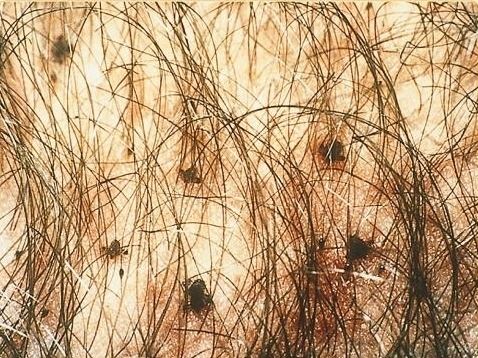Specialty infectious disease ICD-9-CM 132.2 MedlinePlus 000841 | ICD-10 B85.3 DiseasesDB 10028 eMedicine med/1769 | |
 | ||
Pediculosis pubis (also known as "crabs" and "pubic lice") is a disease caused by the pubic louse, Pthirus pubis, a parasitic insect notorious for infesting human pubic hair. The species may also live on other areas with hair, including the eyelashes, causing pediculosis ciliaris. Infestation usually leads to intense itching in the pubic area. Treatment with topic agents such as permethrin or pyrethrin with piperonyl butoxide is exceedingly effective. Worldwide, pediculosis pubis affects about 2% of the population.
Contents
Classification
Infestation with pubic lice is also called phthiriasis or phthiriasis pubis, while infestation of eyelashes with pubic lice is called phthiriasis palpebrarum or pediculosis ciliarum. The disease is spelled with phth, even though the scientific name of the louse is spelled with pth.
Signs and symptoms
The main symptom is itching, usually in the pubic-hair area, resulting from hypersensitivity to louse saliva, which can become stronger over two or more weeks following initial infestation. In some infestations, a characteristic grey-blue or slate coloration macule appears (maculae caeruleae) at the feeding site, which may last for days. Nits or live lice may also be visible to the unaided eye.
Characteristics
Pubic lice are between 1 and 3 mm long with 6 legs.
Transmission
Pubic lice are usually acquired by intimate contact between individuals. Parent-to-child infestations are more likely to occur through routes of shared towels, clothing, beds or closets. Adults are more frequently infested than children. As with most sexually transmitted pathogens, they can only survive a short time away from the warmth and humidity of the human body.
Infection in a young child or teenager is not necessarily indicative of sexual abuse, although this possibility should be kept in mind.
Diagnosis
A pubic louse infestation is usually diagnosed by carefully examining pubic hair for nits, nymphs, and adult lice. Lice and nits can be removed either with forceps or by cutting the infested hair with scissors (with the exception of an infestation of the eye area). A magnifying glass or a stereo-microscope can be used for the exact identification. If lice are detected in one family member, the entire family needs to be checked and only those who are infested with living lice should be treated.
Testing for other sexually transmitted infections is recommended in those who are affected.
Pediculosis pubis
Recommended treatments include the topical agents permethrin or pyrethrins with piperonyl butoxide. Lindane is a second line treatment due to concerns of toxicity. The Centers for Disease Control and Prevention (CDC) states that lindane should not be used by persons who have extensive dermatitis, women who are pregnant or lactating or children aged under two years. The FDA similarly warns against use in patients with a history of uncontrolled seizure disorders and cautious use in infants, children, the elderly, and individuals with other skin conditions (e.g., atopic dermatitis, psoriasis) and in those who weigh less than 110 lbs (50 kg).
Bedding and clothing should be laundered and sexual contact should be avoided until cured. A second treatment is occasionally required if not improved after 3 to 7 days.
Pubic lice are primarily spread through sexual intercourse. Therefore, all partners with whom the patient has had sexual contact within the previous 30 days should be evaluated and treated, and sexual contact should be avoided until all partners have successfully completed treatment and are thought to be cured. Because of the strong association between the presence of pubic lice and classic sexually transmitted infections (STIs), patients diagnosed with pubic lice should undergo evaluation for other STIs.
Pediculosis ciliaris
Infections of the eyelashes may be treated with either petroleum jelly applied twice daily for 10 days or malathion, phenothrin and carbaryl.
Epidemiology
Current worldwide prevalence has been very approximately estimated at two percent of the human population. Accurate numbers are difficult to acquire, because pubic lice infestations are not considered a reportable condition by many governments, and many cases are self-treated or treated discreetly by personal physicians.
Although any part of the body may be colonized, crab lice favor the hairs of the genital and peri-anal region. Especially in male patients, pubic lice and eggs can also be found in hair on the abdomen and under the armpits, as well as on the beard and mustache, while in children they are usually found in eyelashes.
It has recently been suggested that an increasing percentage of humans removing their pubic hair has led to reduced crab louse populations in some parts of the world.
In animals
Humans are the only known hosts of this parasite, although a closely related species, Pthirus gorillae, infects gorilla populations.
